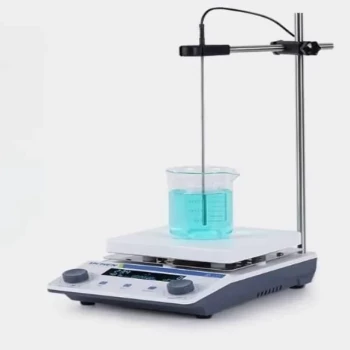Thermal elements, also known as heating elements, are devices that convert electrical energy into heat energy. They are widely used in laboratory equipment, industrial processes, and household appliances. Thermal elements can be made of various materials such as nichrome, platinum, tungsten, and silicon carbide, depending on the application. They come in different shapes and sizes, including tubular, screen-printed, radiative, and removable ceramic core elements. Thermal elements work by generating heat through resistance when electricity passes through them. This heat can then be used for heating fluids, solids, or gases in a wide range of applications.
Toggle Categories
Get Instant Support
Choose your preferred way to connect with our team
-
Get Free Quote Fill out form for detailed pricing
-
Send Email Detailed inquiry support
-
WhatsApp Quick mobile chat
Response Time
Within 8 hours on working days, 24 hours on holidays
thermal elements

Molybdenum Disilicide (MoSi2) Thermal Elements Electric Furnace Heating Element
Item Number : KT-MH

Silicon Carbide SiC Thermal Heating Elements for Electric Furnace
Item Number : KT-SH

Lab Electrochemical Workstation Potentiostat for Laboratory Use
Item Number : KT-CHIP

Laboratory Small Constant Temperature Heated Magnetic Stirrer Heater and Stirrer
Item Number : KTL-2

Custom PTFE Teflon Parts Manufacturer for Magnetic Stirring Bar
Item Number : PTFE-27

Custom PTFE Teflon Parts Manufacturer for PTFE Buchner Funnel and Triangular Funnel
Item Number : PTFE-30

Custom PTFE Teflon Parts Manufacturer for Centrifuge Tubes
Item Number : PTFE-32

Custom PTFE Teflon Parts Manufacturer for PTFE Measuring Cylinder 10/50/100ml
Item Number : PTFE-35
We have the best Thermal Elements solutions to meet your needs. Our portfolio offers a range of standard solutions, from composite heating elements to screen-printed metal-ceramic tracks, with bespoke designs available for unique applications. Our tubular and radiative heating elements offer efficient and reliable performance, while our combination heating element systems utilize best materials for high-temperature furnaces.
Applications of Thermal Elements
- Tubular (sheathed) elements - used in electric stoves, ovens, coffee makers, and toaster ovens
- Screen-printed metal-ceramic tracks - found in kettles and other domestic appliances
- Radiative heating elements - used in radiant space heaters and food warmers
- Removable ceramic core elements - used for fluid heating under pressure
- Combination heating element systems - used in high-temperature furnaces and gas ovens
- Graphite heating elements - used in various thermal applications due to their thermal properties and chemical resistance
Advantages of Thermal Elements
- Thermal elements provide excellent temperature uniformity, which is necessary for consistent results in laboratory experiments.
- They have high thermal stability, allowing them to operate at extremely high temperatures without degrading or failing.
- Thermal elements are designed to have a long lifespan, reducing the need for frequent replacements and saving money in the long run.
- They are highly efficient, converting 100% of the electricity supplied into heat without producing any harmful byproducts or emissions.
- Thermal elements are versatile and can be customized to fit a wide range of laboratory equipment and applications.
- They are easy to install and remove, saving time and reducing the risk of damage to sensitive equipment.
- Thermal elements are resistant to chemical corrosion and thermal shock, making them ideal for use in harsh laboratory environments.
- They are available in a variety of materials, including graphite, ceramic, and metal, allowing for tailored solutions to specific laboratory needs.
- Thermal elements offer precise temperature control, allowing for accurate and repeatable experimental results.
Our Thermal Elements are a cost-effective solution that offers both standard and custom design options for your specific needs. Our tubular heating elements, tubular oven heating elements, and composite heating elements are all designed to provide maximum heat transmission and are equipped with high-grade insulation materials that guarantee low energy consumption.
FAQ
What Is A Thermal Element?
How Does A Thermal Element Work?
What Are The Advantages Of Using Thermal Elements?
What Are The Different Types Of Thermal Elements?
How Should Thermal Elements Be Calibrated And Maintained?
REQUEST A QUOTE
Our professional team will reply to you within one business day. Please feel free to contact us!
Related Articles

The Geometry of Cleanliness: Why Surface Integrity Defines Electrochemical Success
Master the art of electrolytic cell maintenance. Discover how a tiered cleaning protocol prevents contamination and ensures experimental reproducibility.

Entropy and the Alumina Tube: The Art of Precision Maintenance
Discover the disciplined approach to cleaning alumina furnace tubes. Learn how to prevent thermal shock, remove residue with acid, and extend equipment life.

The Art of the Finish: Why the Most Critical Moment Happens After the Data is Collected
The experiment isn't over when the data is saved. Learn the psychological and technical art of shutting down and cleaning optical electrolytic cells.

The Architecture of Certainty: Mastering Control in Multifunctional Electrolytic Cells
Precision in electrochemistry isn't about guesswork; it's about hardware architecture. Learn how the three-electrode system isolates variables for true control.

The Architecture of Isolation: Anatomy of a Tube Furnace
Explore the layered engineering of a tube furnace. From alumina insulation to quartz reactors, understand how this "thermal sleeve" achieves precise isolation.

The Silent Interface: Mastery Over Electrode Decay
Electrode failure is rarely sudden; it is the compound interest of neglect. Learn the disciplined maintenance protocols that preserve accuracy and longevity.

The Symphony of Silence: Molybdenum and the Architecture of the Vacuum Hot Zone
Why do we trust Molybdenum in the most extreme environments? Explore the engineering logic behind all-metal hot zones and the pursuit of absolute purity.

The Silent Partner: Why Material Choice in Electrochemistry is a Matter of Trust
Discover why high borosilicate glass and PTFE are the non-negotiable standards for electrolytic cells. A deep dive into material science for precise data.

Cracked Tubes, Contaminated Samples? Your Furnace Tube Is The Hidden Culprit
Frustrated by failed experiments? Learn why your furnace tube material—not your process settings—is the critical variable causing inconsistent results.

Why Your High-Temperature Furnace Elements Keep Failing (And How to Stop It)
Discover the hidden causes of MoSi2 heating element failure, like pesting and chemical attack, and learn how to achieve reliable, repeatable results.

Why Your High-Temperature Furnace Elements Fail: The Critical Difference in Silicon Carbide
Furnace downtime from failing SiC heating elements costs time and money. Discover the critical material difference that ensures reliability in extreme applications.

How to Select the Right Oil-Free Diaphragm Pump for Your Lab or Industrial Needs
Learn how to choose the right oil-free diaphragm pump for your lab or industry—balancing specs, chemical resistance, and lifetime costs.

Water Circulating Vacuum Pumps: A Practical Guide for Laboratory Applications
Discover the benefits of water circulating vacuum pumps for labs: chemical safety, low maintenance, and explosion-proof operation. Ideal for sensitive applications.

Performance and application of polytetrafluoroethylene (PTFE) in high temperature environment

PTFE seals: the invisible guardian of industrial leakage prevention
PTFE Seals are used to prevent liquid or gas leakage and are widely used in valves, pumps, and piping systems.

PTFE's high temperature and corrosion resistance: Why it is indispensable in industry
The unique advantages of polytetrafluoroethylene (PTFE) in high temperature and corrosion resistance analyze why it has become an indispensable material in industry, especially in applications in harsh environments.

Innovative Application of PTFE in Mechanical Seals
PTFE has become one of the core materials in the field of mechanical seals due to its unique chemical stability, low friction coefficient (0.04-0.15), wide temperature range (-268°C to +315°C) and excellent corrosion resistance (pH 0-14).

The key role of PTFE in semiconductor manufacturing: from gas pipelines to electrical insulation
From high-purity gas delivery pipelines to precision electrical insulation components, the multi-faceted application of PTFE in the semiconductor industry chain provides important guarantees for the purity, stability and reliability of the manufacturing process.

How to use PTFE to improve the working efficiency of pumps and valves
Polytetrafluoroethylene (PTFE) has become a key material for improving the efficiency of pumps and valves due to its unique physical and chemical properties.

Precision Ceramic Materials for Energy Conversion Applications
Overview of various ceramic materials used in energy conversion technologies, including heaters, piezoelectric ceramics, and solid oxide fuel cells.

